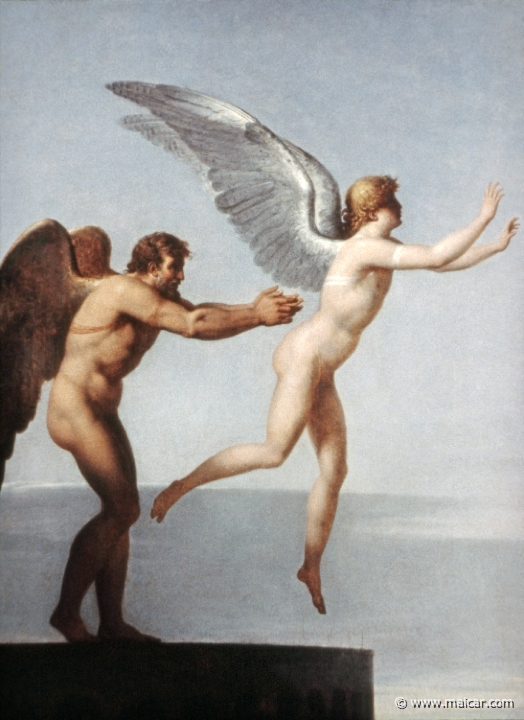|

|
4649: Daedalus and Icarus. Painting by Charles-Paul Landon, 1760-1826. Musée des Beaux-Arts et de la Dentelle, Alençon.
|
|
Daedalus was an Athenian architect, and
the first inventor of images.
Charged with murder
Daedalus, who received his craftsmanship from
Athena, belonged to the royal Athenian clan called the Metionids, and among his ancestors are Erichthonius 2, who was king of Athens and was said to be
the son of Athena and
Hephaestus, and also
King Erechtheus.
Daedalus was condemned in the Areopagus for
murder, and he fled to
Crete, being followed in
his exile by one of his pupils, Endoeus. This
Endoeus is known for having made a statue of
Athena seated that could
be seen in Athens where
other constructions by Daedalus, for example a
folding chair, were also shown. It could be seen in
Corinth a wooden statue
of Heracles 1 made by
Daedalus, which showed that his works were always
distinguished by a special kind of inspiration.
Daedalus was held responsible for the murder of one of his pupils, Talos 2, because, they say, he feared that Talos 2, with his talents, might surpass him. Talos 2, also called Calos and Daedalus' nephew (son of his sister Perdix), received his education in the home of Daedalus, and was considered more gifted than his teacher. But others say that Daedalus envied the skills of Perdix (son of Eupalamus, son of Metion 1 or of Erechtheus), the inventor of the saw, and that he threw him down from a roof; they add that Perdix was then turned into a partridge by Athena. Perdix invented
the saw from the spine of a fish, and he is said to
have invented the compasses as well.
Marvels done in exile
Whatever happened in
Athens, Daedalus came as
an exile to Crete, where
he made images and built several marvels for
Minos 2 and and his
family. He constructed a hollowed wooden cow on
wheels for Pasiphae so that she could couple with a
bull; as a result of this invention, Pasiphae gave
later birth to the
Minotaur. He made the
famous Labyrinth, where the
Minotaur lived, being
fed by the seven youths and as many damsels whom
the Athenians sent to
Crete as annual tribute (see Minotaur and
Theseus). This Labyrinth which Daedalus constructed was a chamber whose passageways were so winding that those unfamiliar with them had difficulty in making their way out. In this Labyrinth, the Minotaur was maintained
and here it devoured the youths who were sent from
Athens. He also designed
a dancing floor for
Ariadne in the town of
Cnossus.
Daedalus imprisoned
When Theseus came to
Crete, he was forced to
confront the Minotaur
in the Labyrinth. In order to help him to find his
way out after killing the monster,
Ariadne, who had fallen
in love with Theseus, consulted Daedalus, who revealed to her the secrets of the Labyrinth. Minos 2, having
learned about the architect's treason, imprisoned
both him and his son in the Labyrinth. But Daedalus
constructed wings to escape.
|

|
Labyrinth, after ancient Cretan coin from 330 BC. Painting by C. Parada.
|
|
Icarus 1
When they were about to take off, Daedalus told his son neither to fly high, lest the glue should melt in the sun and the wings should drop off, nor to fly near the sea, lest the pinions should be detached by the damp. But Icarus 1, disregarding his father's instructions, soared ever higher, till, the glue melting, he fell into the sea and perished. The Icarian Sea (near Samos), where he fell, was named after him, and it is said that Heracles 1, who passed by, gave him burial. Others affirm that they traveled by sea, and that Icarus 1 drowned when his vessel was overturned; or that he, having disembarked in a reckless manner, fell into the sea and perished. It is told that on this occasion Daedalus devised sails for the ships—an invention as yet unknown—so as to take advantage of the wind, and thus outsail the oared fleet of Minos 2. Daedalus himself escaped, as all reports say, but his son's ship is said to have overturned, Icarus 1 being an unexperienced steersman. Icarus 1 drowned and his body was carried ashore by the current to the island—then without a name—that lies off Samos (the Aegean island off the western coast of Asia Minor); and Heracles 1, coming across the body, recognized it, and buried it. Since then, both the island and the sea around it are named after Icarus 1.
New exile
Daedalus then came to the city of Inycus in Sicily, where King Cocalus protected him, concealing him in his palace. Some time after, Minos 2 came to Sicily searching for him, and was
likewise received by King Cocalus, who feigned
hospitality: Minos 2 was
betrayed and murdered, either by the king himself
or by the king's daughters, who were great admirers
of Daedalus' skills.
Famous also in Italy
The residence of Daedalus at Cnossus gave the
Cretans a reputation for the making of wooden
images that lasted for a long period. After
Daedalus' second exile in Sicily, his renown spread
over the island and many regions of Italy. Yet it
is also told that
Theseus, after slaying
the Minotaur, brought
Daedalus back to Athens.
|